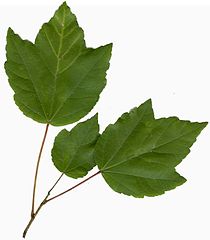Hikers, who passed them, stopped to look at the whirlpools, that started and stopped, in the stream, before it went under the road-trail. It was noticed that most of the strong ones were spinning in the clockwise direction. In the Northern Hemisphere, the planet’s rotation causes large cyclones, such as hurricanes, to spin counter-clockwise, and clockwise, in the Southern Hemisphere. This is why, as mentioned earlier, Sandy, which landed in Southern New Jersey, pushed sea water into the New Jersey coast, Staten Island, Rockaway, and Lower Manhattan, while Irene, in 2011, landed north of New York City, and pushed water toward the sea. The water, in the stream, was primarily controlled by local forces in the stream.
The dominant tree, in the wetlands, was the  red maple, Acer rubrum. It’s also commonly called the swamp maple, because it can thrive in wet soil. By contrast, the sugar maple, A. saccarum, requires a well drained soil. Remember our earlier post on how to identify maples in the winter, about them differing from most other hardwoods by having 2 buds to a node, opposite each other? Remember MAD HORSE? Also, If you look on the ground, by a tree, you will often see last summer’s leaves. You’re familiar with the typical palmate lobed maple leaf. The
red maple, Acer rubrum. It’s also commonly called the swamp maple, because it can thrive in wet soil. By contrast, the sugar maple, A. saccarum, requires a well drained soil. Remember our earlier post on how to identify maples in the winter, about them differing from most other hardwoods by having 2 buds to a node, opposite each other? Remember MAD HORSE? Also, If you look on the ground, by a tree, you will often see last summer’s leaves. You’re familiar with the typical palmate lobed maple leaf. The 
While the sugar maple is the best syrup producer, the red maple also has sugar in its sap, only not as much. Not to waste a resource, Chuck also has tap lines in the red maples in his forest so, his delicious syrup is a combination of sugar and red maple. The sap will be starting to rise soon so Chuck is getting his tap lines ready, to get it, when it starts rising. In March, he will show you, in complete detail, his operation; how he gets the sap from the trees and boils it down to make the syrup. The smell of boiling sap is one of the greatest aromas. Sure sign of coming spring. See if you can guess how much sap it takes to make a quart of syrup. We will be using the Maple weekends to raise funds for our hiking club. Pam is organizing this project so, if you’d like to help, let her know.
